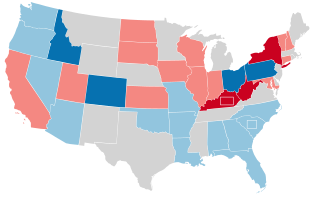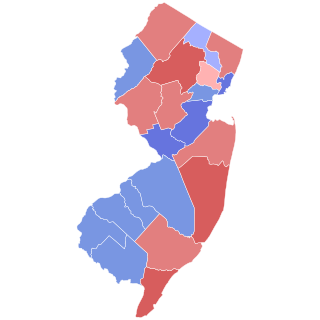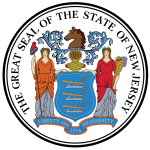
The 1970 United States Senate elections was an election for the United States Senate. It took place on November 3, with the 33 seats of Class 1 contested in regular elections. Special elections were also held to fill vacancies. These races occurred in the middle of Richard Nixon's first term as president. The Democrats lost a net of three seats, while the Republicans and the Conservative Party of New York picked up one net seat each, and former Democrat Harry F. Byrd Jr. was re-elected as an independent.

The 1964 United States Senate elections were held on November 3. The 33 seats of Class 1 were contested in regular elections. Special elections were also held to fill vacancies. They coincided with the election of President Lyndon B. Johnson by an overwhelming majority, to a full term. His Democratic Party picked up a net two seats from the Republicans. As of 2023, this was the last time either party has had a two-thirds majority in the Senate, which allowed the Senate Democrats to override a veto, propose constitutional amendments, or convict and expel certain officials without any votes from Senate Republicans. However, internal divisions would have prevented the Democrats from having done so. The Senate election cycle coincided with Democratic gains in the House in the same year.

The 1962 United States Senate elections was an election for the United States Senate. Held on November 6, the 34 seats of Class 3 were contested in regular elections. Special elections were also held to fill vacancies. They occurred in the middle of President John F. Kennedy's term. His Democratic Party made a net gain of four seats from the Republicans, increasing their control of the Senate to 68–32. However, this was reduced to 67–33 between the election and the next Congress, as on November 18, 1962, Democrat Dennis Chávez, who was not up for election that year, died. He was replaced on November 30, 1962, by Republican appointee Edwin L. Mechem. Additionally, Democrat Strom Thurmond became a Republican in 1964, further reducing Democrats to 66–34. This was the first time since 1932 that Democrats gained seats in this class of Senators.

The 1958 United States Senate elections were elections for the United States Senate which occurred in the middle of President Dwight D. Eisenhower's second term. Thirty-two seats of Class 1 were contested in regular elections, the new state of Alaska held its first Senate elections for its Class 2 and 3 seats, and two special elections were held to fill vacancies.

The 1956 United States Senate elections were elections for the United States Senate that coincided with the re-election of President Dwight D. Eisenhower. The 32 seats of Class 3 were contested in regular elections, and three special elections were held to fill vacancies. Although Democrats gained two seats in regular elections, the Republicans gained two seats in special elections, leaving the party balance of the chamber unchanged.

The 1954 United States Senate elections was a midterm election in the first term of Dwight D. Eisenhower's presidency. The 32 Senate seats of Class 2 were contested in regular elections, and six special elections were held to fill vacancies. Eisenhower's Republican party lost a net of two seats to the Democratic opposition. This small change was just enough to give Democrats control of the chamber with the help of the Independent who at the start of this Congress in January 1955 agreed to caucus with them; he later officially joined the party in April 1955.

The 1952 United States Senate elections was an election for the United States Senate which coincided with the election of Dwight D. Eisenhower to the presidency by a large margin. The 32 Senate seats of Class 1 were contested in regular elections, and three special elections were held to fill vacancies. The Republicans took control of the Senate by managing to make a net gain of two seats. However, Wayne Morse (R-OR) became an independent forcing Republicans to rely on Vice President Richard Nixon's tie-breaking vote, although Republicans maintained a 48–47–1 plurality. Wayne Morse would caucus with the Republicans at the start of Congress’ second session on January 6, 1954 to allow the GOP to remain in control of the Senate. This was the third time, as well as second consecutive, in which a sitting Senate leader lost his seat.

The 1948 United States Senate elections were held concurrently with the election of Democratic President Harry S. Truman for a full term. The 32 seats of Class 2 were contested in regular elections, and one special election was held to fill a vacancy. Truman campaigned against an "obstructionist" Congress that had blocked many of his initiatives, and additionally, the U.S. economy recovered from the postwar recession of 1946–1947 by election day. Thus, Truman was rewarded with a Democratic gain of nine seats in the Senate, enough to give them control of the chamber. This was the last time until 2020 that Democrats flipped a chamber of Congress in a presidential election cycle.

The 1944 United States Senate elections coincided with the re-election of Franklin D. Roosevelt to his fourth term as president. The 32 seats of Class 3 were contested in regular elections, and three special elections were held to fill vacancies.

Robert Winthrop Kean was an American Republican Party politician from the state of New Jersey. Kean represented parts of Essex County, New Jersey in the United States House of Representatives from 1939 to 1959. He retired from the House to run for United States Senate in 1958, but was defeated by Harrison A. Williams.

The United States Senate election of 1946 in New Jersey was held on November 5, 1946.

The 1980 United States Senate election in Colorado was held on November 4, 1980. Incumbent Democratic U.S. Senator Gary Hart won re-election to a second term despite Republican nominee Ronald Reagan winning the state over Democratic President Jimmy Carter in the concurrent presidential election. This election was the first time since 1948 that an incumbent Democratic Senator from Colorado was re-elected or won re-election and the first time since 1938 that an incumbent Democratic Senator from Colorado was re-elected or won re-election for this seat.

The 1926 United States Senate election in Illinois took place on November 2, 1926.

The 1978 United States Senate election in New Jersey was held on November 7, 1978. Incumbent Senator Clifford P. Case ran for re-election to a fifth term in office, narrowly losing the Republican primary by anti-tax conservative Jeff Bell, who lost the general election to Democrat Bill Bradley. Bell was the unsuccessful Republican nominee for this seat again in 2014.

The 1944 United States Senate special election in New Jersey was held on November 7, 1944.

The United States Senate election of 1948 in New Jersey was held on November 2, 1948.

The United States Senate election of 1934 in New Jersey was held on November 6, 1934.

The 1960 United States Senate election in New Jersey was held on November 8, 1960. Incumbent Republican Clifford P. Case defeated Democratic nominee Thorn Lord with 55.69% of the vote. This election was the first time since 1924 where an incumbent Republican Senator was re-elected to this seat.

The 1972 United States Senate election in New Jersey was held on November 7, 1972. Incumbent Republican Clifford P. Case defeated Democratic nominee Paul J. Krebs with 62.46% of the vote.

The 1958 United States Senate election in New Jersey was held on November 4, 1958.























